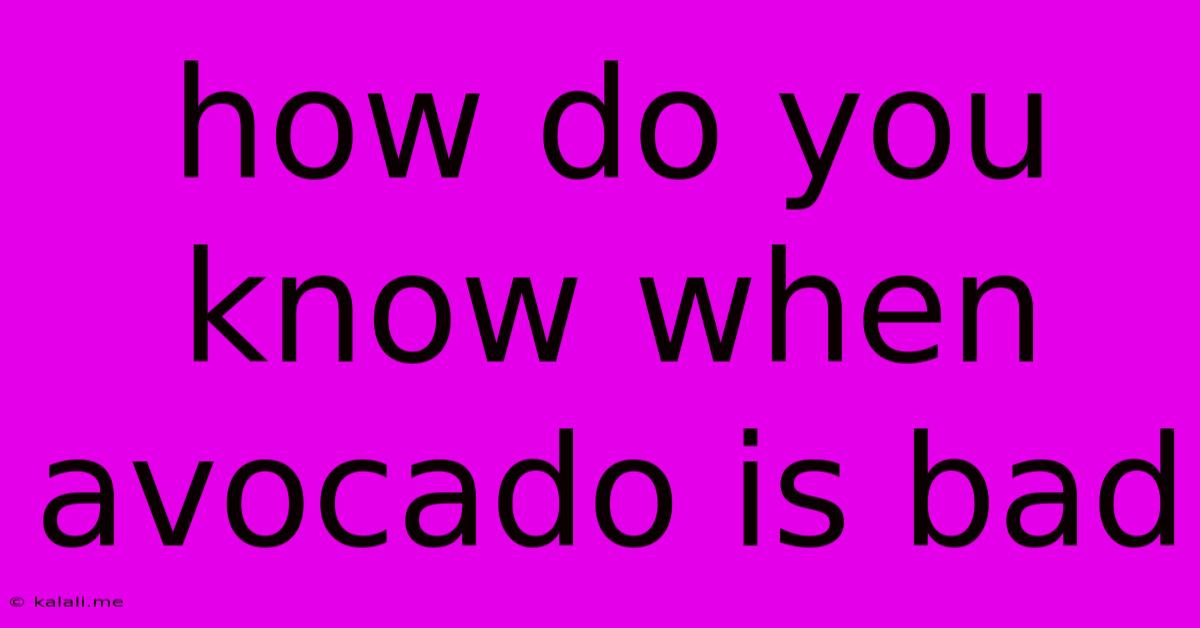How Do You Know When Avocado Is Bad
Kalali
Jun 08, 2025 · 3 min read

Table of Contents
How to Tell if Your Avocado is Bad: A Guide to Ripe and Rotten Avocados
Avocados are a nutritional powerhouse, packed with healthy fats, fiber, and vitamins. But their short shelf life means knowing how to identify a bad avocado is crucial to avoid food waste and disappointment. This guide will walk you through the visual and tactile cues that signal a ripe, overripe, or rotten avocado. Knowing the signs will help you select perfect avocados at the grocery store and extend the life of those you already have at home.
Visual Clues: The Look of a Good (and Bad) Avocado
The first step in determining avocado ripeness is a visual inspection. Look for these key characteristics:
-
Color: While avocado color varies depending on the variety (Hass avocados, for example, turn dark purplish-brown when ripe), the skin should be smooth and free from significant blemishes, bruises, or discoloration. Significant dark spots or large areas of brown are often a sign of rot. However, some discoloration is normal as avocados ripen.
-
Firmness: Gently squeeze the avocado in your hand. A ripe avocado will yield slightly to gentle pressure, feeling soft but not mushy. An avocado that's rock-hard is unripe, while one that's overly soft or feels squishy is overripe or possibly rotten.
-
Stem: If the avocado still has its stem, you can gently pull it off. A healthy avocado will reveal a bright green underneath. A brown or dark area indicates spoilage.
Beyond the Surface: More Indicators of Avocado Spoilage
Visual cues are a good starting point, but sometimes, a more thorough examination is needed:
-
Smell: A ripe avocado will have a subtle, pleasant aroma. However, a foul or off-putting odor—often described as sour or musty—is a clear indication of spoilage. Trust your nose! This is a key indicator often missed.
-
Texture: If you cut into the avocado, the flesh should be firm and creamy. Brown discoloration throughout the flesh, a slimy texture, or a watery consistency are all signs of spoilage. Even if just a portion is affected, it's best to discard the whole avocado to prevent foodborne illness.
-
Taste Test (Use Caution): As a last resort, you can try a small taste. If it tastes bitter, sour, or otherwise off, dispose of it. However, never taste an avocado you suspect is bad, as consuming spoiled food can be harmful.
Extending the Life of Your Avocados
Proper storage plays a vital role in preventing avocado spoilage. Here are a few tips:
-
Refrigeration: Unripe avocados can be stored at room temperature to ripen. Once ripe, refrigerate them to slow down the ripening process.
-
Freezing: Avocados can be frozen, either whole or mashed, to extend their shelf life significantly.
-
Lemon Juice: To prevent browning, sprinkle the cut surface of an avocado with lemon or lime juice.
By carefully observing these visual and tactile clues, and using proper storage techniques, you can avoid wasting your avocados and always enjoy perfectly ripe fruit. Remember, when in doubt, throw it out! Food safety is paramount.
Latest Posts
Latest Posts
-
How To Vent A Portable Air Conditioner Without A Window
Jun 08, 2025
-
Does Increasing Pressure Of A Gas Decrease Entroppy
Jun 08, 2025
-
How Did Gimli Not Know About Moria
Jun 08, 2025
-
Is Good Todrive 10 Oil Life
Jun 08, 2025
-
What To Do With Different Star Items In Stardew Valley
Jun 08, 2025
Related Post
Thank you for visiting our website which covers about How Do You Know When Avocado Is Bad . We hope the information provided has been useful to you. Feel free to contact us if you have any questions or need further assistance. See you next time and don't miss to bookmark.